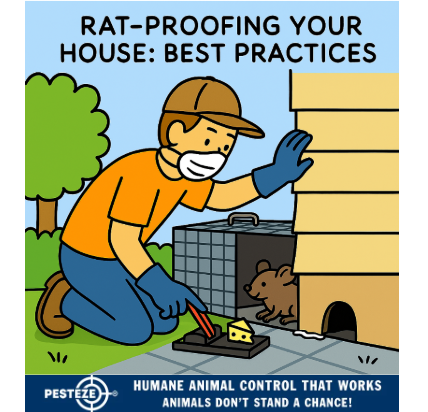RAT-PROOFING YOUR HOUSE: BEST PRACTICES

RAT-PROOFING YOUR HOUSE: BEST PRACTICES
SUMMARY
Rats are more than just a nuisance—they pose serious health risks and can cause extensive property damage. Rat-proofing your house is essential for maintaining a safe, clean, and pest-free environment. This guide outlines the most effective strategies to prevent infestations, seal entry points, and create a home that’s unwelcoming to rodents. Whether you live in a city apartment or a rural home, these best practices will help you keep rats out for good.
FEATURES
-
Spotting Early Signs: Learn how to identify droppings, gnaw marks, and rat pathways.
-
Sealing Vulnerable Areas: Discover how to block common entry points like vents, pipes, and cracks.
-
Sanitation Strategies: Maintain cleanliness to eliminate food sources and nesting materials.
-
Outdoor Defense: Tips for managing landscaping and garbage to deter rats from approaching.
-
Safe Deterrents: Explore natural and chemical-free repellents for long-term prevention.
-
Professional Help: Know when to call pest control for severe or recurring infestations.
GUIDE DESCRIPTION
Rat-proofing your house is a proactive approach to pest control that focuses on prevention rather than reaction. Rats are highly adaptable and can squeeze through openings as small as a quarter. Once inside, they can chew through wires, contaminate food, and spread diseases like leptospirosis and hantavirus. This guide provides a comprehensive plan to keep your home rat-free.
Start by inspecting your home for signs of rat activity. Look for droppings, greasy rub marks along walls, and shredded materials used for nesting. Common entry points include gaps around pipes, vents, and foundations. Seal these with steel wool, caulk, or metal flashing—materials rats can’t chew through.
Cleanliness is key. Store food in airtight containers, clean up crumbs and spills promptly, and avoid leaving pet food out overnight. Declutter storage areas to eliminate hiding spots and nesting materials. Outside, keep garbage bins sealed, trim vegetation near the house, and remove debris that could shelter rats.
Consider natural deterrents like peppermint oil, ultrasonic devices, or predator scents. These can help discourage rats without harming them or the environment. For persistent problems, consult a licensed pest control professional who can assess the situation and apply targeted treatments.
Rat-proofing is not a one-time fix—it’s an ongoing effort that combines vigilance, maintenance, and smart design. By following these best practices, you’ll protect your home, your health, and your peace of mind from unwanted rodent guests.
- Amy Chang


Comments 0